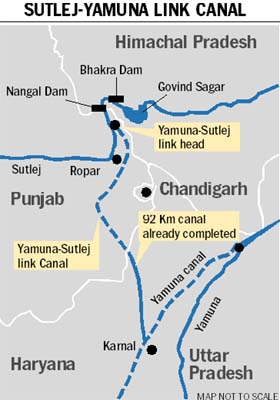Context:
In a significant escalation of the ongoing water-sharing conflict between Punjab and Haryana, the Punjab Government passed a resolution in the State Assembly opposing the Bhakra Beas Management Board (BBMB)’s recent directive to release 4,500 cusecs of additional water to Haryana.
Background:
The BBMB, a central authority established to manage the Bhakra and Beas river projects, recently ordered the release of 4,500 cusecs of additional water to Haryana. This directive sparked sharp criticism from the Punjab government, which views it as an unjustified and unilateral decision that threatens the state's already-stressed water resources.
Punjab Assembly’s Resolution:
- No Surplus Water: The resolution declares that Punjab is a water-deficient state and cannot share any more water beyond what is legally allocated.
- Rejection of BBMB's Authority: It rejects BBMB’s decision to release additional water, claiming it was taken without proper consultation with Punjab.
- Demand to Reconsider BBMB’s Structure and Role: The resolution hints at the politicisation of the BBMB, demanding reforms to protect Punjab’s rights over its rivers.
- Call to Repeal Dam Safety Act, 2021: Punjab reiterated its stance against the Dam Safety Act, calling it a violation of federal principles and an attack on state sovereignty over natural resources.
About Bhakra Beas Management Board (BBMB):
- Established under Section 79 of the Punjab Reorganisation Act, 1966.
- Initially known as the Bhakra Management Board.
Functions
- Operation & maintenance of the Bhakra-Nangal and Beas (Satluj Link and Pong Dam) projects.
- Regulates water and electricity supply to Punjab, Haryana, Rajasthan, Himachal Pradesh, Delhi, and Chandigarh.
Constitutional and Legal Framework on Water Distribution
Constitutional Entries
- Entry 17, State List: Grants states jurisdiction over water supply, irrigation, canals, and drainage.
- Entry 56, Union List: Permits the central government to regulate and develop inter-State rivers.
- Article 262: Allows Parliament to enact laws for adjudicating inter-state river water disputes.
Key Laws
- River Boards Act, 1956: Enables the central government to create river boards for advisory roles in river development and regulation.
- Inter-State Water Disputes Act, 1956: Provides for the establishment of tribunals to resolve disputes when negotiations fail.
Conclusion
The Punjab Assembly’s resolution marks a firm political and constitutional challenge to central water regulation mechanisms. With water scarcity looming and inter-state tensions rising, the issue is likely to shape policy debates, judicial interventions, and federal relations in the months to come. The next steps by the Centre and the judiciary will be crucial in balancing equity, ecology, and state autonomy in India’s complex river water governance system.







